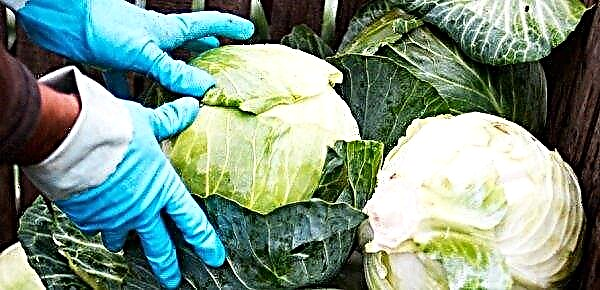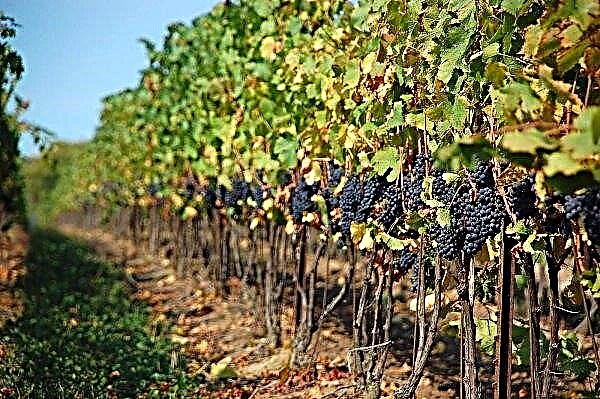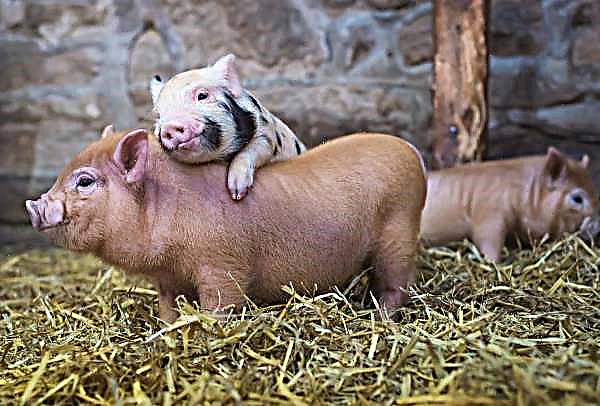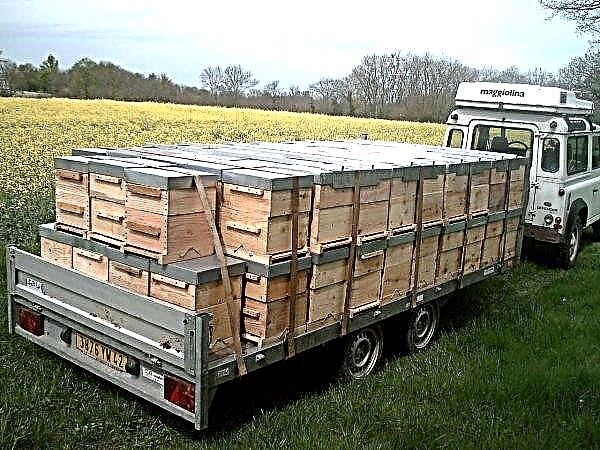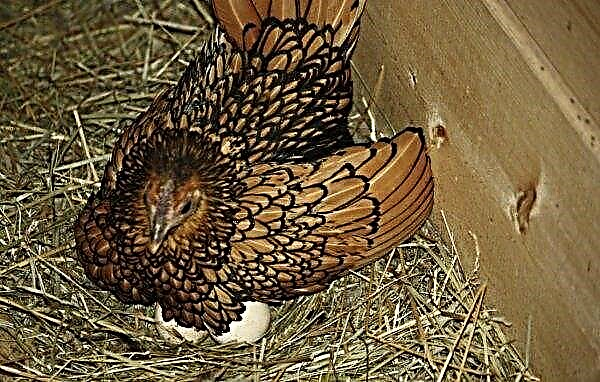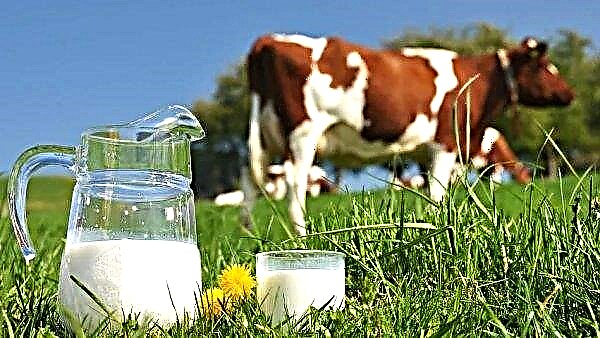Old proven and reliable varieties of cabbage are always in demand among gardeners. Such a variety of white cabbage is the variety Gift (or Gift 2500). This article proposes to consider the characteristics of the variety, its characteristics, how to grow seedlings, basic care and harvesting.
Variety selection and characterization
The variety of white cabbage Gift was bred by domestic breeders of the All-Russian Research Institute of Selection and Seed Production of Vegetable Crops back in the 60s of the last century. It was zoned in all regions and recommended for both household plots and industrial production.
This is a medium-late variety whose crop can be harvested starting from 115–135 days from the date of emergence of seedlings. It forms a slightly elevated leaf rosette with rounded wrinkled leaves and a very dense greenish-white head. Heads of cabbage have an average size and weight of 2.5–4.5 kg. The average length of the stump is 16–20 cm.
Did you know? The name of the cabbage comes from the ancient Greek word “caputum”, which is translated into Russian as “head”.
The yield of this variety of cabbage is 582–910 kg / ha, but can reach 1000 kg / ha. Gift variety - 99%. Under optimal storage conditions, heads of cabbage last for 6–7 months. The gift has a relative resistance to fusarium, bacteriosis and rot.
Advantages and disadvantages
- The advantages of the variety of white cabbage Gift include the following:
- gives stable high yields;
- well transported;
- has a presentation;
- resistant to frost;
- does not crack;
- universal to use;
- rarely affected by disease;
- tastes great;
- unpretentious.
- The disadvantages of the variety include the following:
- exactingness to watering and good lighting;
- not suitable for early production.
Self-growing seedlings
In the northern regions for the cultivation of varieties of white cabbage Gift is recommended to use the seedling method.
The timing
The calculation of the sowing period is based on the fact that the medium-late variety of white cabbage is planted on the beds after 35-40 days from the appearance of sprouts. Sprouts themselves appear after about 10 days from sowing, so the seeds for Gift seedlings are sown 45-50 days before planting. It should be borne in mind that the soil at the landing site should warm up to at least + 8 ° C. Plants at this time already have 4-5 leaves. Such weather is set in each region at one time. In the middle zone of the Russian Federation, this period usually falls at the beginning - mid-May, which means that the seeds are sown by the end of March.
It should be borne in mind that the soil at the landing site should warm up to at least + 8 ° C. Plants at this time already have 4-5 leaves. Such weather is set in each region at one time. In the middle zone of the Russian Federation, this period usually falls at the beginning - mid-May, which means that the seeds are sown by the end of March.
Soil selection and preparation
For seedlings, you can buy ready-made universal soil, or you can make the nutrient soil mixture yourself. For example, mix 3 parts of humus with 3 parts of fertile soil from beds and 4 parts of sand. It is recommended to pour the finished mixture with a solution of potassium permanganate or calcine in the oven.
Then the mixture can be improved by adding ash (2 cups / 10 l) and superphosphate (2 tablespoons l / 10 l).
Capacity selection
It is allowed to grow seedlings of cabbage in a variety of containers:
- seedling boxes (plastic or wooden);
- individual pots or cups;
- peat pots;
- special cassettes or trays;
- home-made containers of waste material (plastic bottles or milk bags).
Often the choice falls on the last option, as the most economical. It should be noted that the optimal containers for seedlings of cabbage should have a depth of 6-8 cm and the same width. It is necessary to remember the presence of drainage holes and, if necessary, make them yourself.
Seed selection and preparation
Before buying, you need to look at the package with seeds, their expiration date and quantity.
Did you know? 1 g contains 250-350 pieces of cabbage seeds. They retain their viability for 4–5 years. On 1 m² it is enough to sow 0.04-0.06 g of seed.
It is worth focusing on what processing the seed material went through. If nothing is written on the packaging about this, then the seeds should be prepared by yourself.
Before sowing, cabbage seeds are recommended to be decontaminated. In domestic conditions, a 1% potassium permanganate solution is usually used for this, in which the seed material is immersed for 20 minutes, and then washed well.
For better germination, seeds can be soaked before germination for half a day in stimulants (Epin, Ideal). Instead of them, you can use a 2% ash solution (insist 2 days before use). After using stimulants, the seed material is not washed.
For better germination, it is recommended to soak the seeds in warm water for 2 hours at a temperature of + 15 ... + 20 ° C until they completely swell with a four-time change of water, and then conduct their hardening. When quenching, they are wrapped in a damp rag and placed in the refrigerator for 24 hours.
Sowing seeds
Medium-late varieties are often grown without diving, and the seeds are immediately planted in 2 pieces in separate containers. They are sown in boxes in grooves at a distance of 6–8 cm from each other and between rows of 10 cm. If picking is subsequently planned, then a small container with a depth of 5–6 cm can be taken and the seeds planted according to the 3 × 3 cm pattern. When planting, the seeds are buried in the soil mixture by 5–10 mm and then moistened from the spray gun, covered with a film and put in a warm place (+ 18 ... + 20 ° С) until emergence. Every day, the film is removed for ventilation and humidity control.
When planting, the seeds are buried in the soil mixture by 5–10 mm and then moistened from the spray gun, covered with a film and put in a warm place (+ 18 ... + 20 ° С) until emergence. Every day, the film is removed for ventilation and humidity control.
When the sprouts appear, the film is removed, and the containers are transferred to an illuminated place with a slightly cooler temperature. White cabbage usually sprouts 3-12 days.
Seedling Care
After emergence, the containers with them are transferred to a place well lit by the sun with a temperature of + 10 ... + 12 ° С during the day, and + 6 ... + 10 ° С at night. This temperature regime is maintained for a week, and then daytime temperatures can be increased to + 14 ... + 18 ° С. The room is periodically ventilated. Watering is carried out with standing water as the soil dries.
Important! Excess moisture and watering with cold water can cause the appearance of a “black leg” in young plants, therefore, for prophylactic purposes, seedlings are advised to water every 7 days with a light solution of potassium permanganate.
The pick (if it was planned) is carried out in 10-12 days from the appearance of sprouts. Before diving, plants are watered. At the transplant itself, pinch too long roots and plants are buried in the ground by cotyledon leaves.
Seedlings that do not need to be dive should be thinned out if necessary.
For seedlings of cabbage before planting, two top dressings are carried out:
- When the second sheet appears. Urea (30 g / 10 l of water) is used.
- Before hardening. In 10 l of water, one tablespoon of urea and potassium sulfate is diluted.
 Owners of chickens can do a second feeding of bird droppings. One part of the litter is poured with 2-3 parts of water, mixed and insisted for 2 days. Next, bred for dressing 1 to 10.
Owners of chickens can do a second feeding of bird droppings. One part of the litter is poured with 2-3 parts of water, mixed and insisted for 2 days. Next, bred for dressing 1 to 10.Seedling hardening
Hardening of cabbage begin to be carried out a couple of weeks before planting. To do this, seedlings are taken out to the balcony with open windows and a temperature of + 5 ... + 6 ° C, first for a short time. Then time is increased, and before disembarkation it should already be on the street all the time.
At the same time, she is gradually accustomed not only to street temperatures, but also to the rays of the sun.
Transplanting seedlings to a permanent place
Cabbage seedlings should be planted at the right time on prepared beds.
The timing
Basically, on the 45-50th day, the seedlings are ready for planting in the beds. Usually this time falls in mid-May.
Did you know? Cabbage was cultivated by man back in the Stone Age. Ancient Egyptians actively cultivated it. In ancient Greece and Rome totaled up to 10 of its varieties.
Plants can survive a cold snap to -3 ° C at night, but it is desirable that the soil warms up sufficiently at least + 8 ° C, and the air temperature reaches + 13 ... + 18 ° C.
Seat selection and crop rotation
For planting cabbage varieties Gift you need to choose a well-lit place without drafts. This plant does not like shading. Groundwater should not come too close to ground level - this will negatively affect the plant.
This plant crop grows well on loamy soils rich in humus, with a weakly acidic or neutral reaction, which pass moisture well.
When choosing a site for planting, crop rotation should be observed.
- Good precursors for cabbage are:
- bow;
- carrot;
- cucumbers
- Pumpkins
- potato;
- legumes.
You should not plant this plant culture after cruciferous plants - radishes, radishes, turnips, any kind of cabbage (cauliflower, broccoli, kohlrabi). This vegetable can be planted at the same place no earlier than after 3 years.
Scheme and depth of landing
The optimal scheme for planting seedlings is 60 × 60 cm. The distance between rows should be 0.5 m, and between heads of cabbage - about 30 cm. Wells or furrows for planting seedlings are made 12 cm deep.
Cultivation agricultural
To get a good cabbage crop, it is necessary to comply with all the requirements for cultivation agricultural technology, which includes watering, soil care, fertilizing.
Watering
Cabbage loves plentiful watering. Three days after transplanting, the first watering is carried out at the rate of 8 liters per 1 m². Then watering should be every 2-3 days, but gradually reduce watering to 1 time in 7 days. At the same time, the irrigation volume is increased to 1.5 liters per 1 m².
Irrigation of plants depends largely on weather conditions. In heavy rains, in order not to cause the appearance of fungal diseases, which, in turn, can lead to rotting of the root system, watering should be stopped. In hot weather, the amount of watering should be increased.
Important! Watering is carried out under the root, so as not to provoke cracking and disease. Top dressing is applied in such a way that the solution does not fall on the leaves - this can cause burns.
3 weeks before harvesting, hydration is stopped to avoid cracking heads.
Soil care
After rain or watering, it is necessary to loosen the soil in the garden with vegetables. This will improve the flow of nutrients, oxygen and moisture to the roots of the crop. During loosening, weed removal must be carried out, which draws nutrients and moisture from the soil onto itself, which impedes the plant's good growth and development.
After 21-24 days after planting on the beds, the grown plants must be spud. After 10 days, the procedure is repeated. This hilling contributes to the growth and strengthening of the root system.
Fertilizer application
For the entire growing season, you need to feed cabbage at least 2–4 times:
- The first top dressing is made 2 weeks after planting seedlings on the beds. You can use organic (rotted manure or bird droppings) or mineral fertilizers (10 g of urea, 15 g of potassium monophosphate are taken for 10 liters of liquid).
- The second fertilizer application is carried out a month after transplanting. For top dressing, make the same composition as in the previous version.
- The third feeding is carried out 2 weeks after the second. You can make the following solution - in 10 liters of liquid, 0.5 liters of manure (chicken droppings) and 15 g of potassium monophosphate are diluted. About 1 liter per plant is enough. You can do another top dressing - dilute 1 tbsp in 10 l. a spoon of nitrophoska.
- The last top dressing is carried out 20-21 days after the third. Take the same solution as with the third top dressing.
For convenience, you can buy ready-made mineral fertilizer complexes for cabbage such as "Agricole", "Cabbage".
When to harvest, is it possible to salt for the winter
Cabbage Gift is a medium-late variety, so harvesting is started in the third decade of August or early September. During this period, the head of cabbage will reach the desired size. The lower leaves will tell you that the vegetable has ripened and growth has stopped - they will begin to turn yellow. Cabbage Gift is suitable for pickling, pickling and pickling for the winter.
Cabbage Gift is suitable for pickling, pickling and pickling for the winter.
Did you know? Sauerkraut has been used as a source of vitamins in the winter for a long time. Russian princes always reserved places for “skits” in their lands and considered this culture to be a cause of good health. In heads of cabbage, fermented in half or whole, half the vitamins are retained than in the crushed product.
The old variety of white cabbage Gift will not leave gardeners without a crop under different growing conditions, but to get the maximum yield you need to properly care for it.

